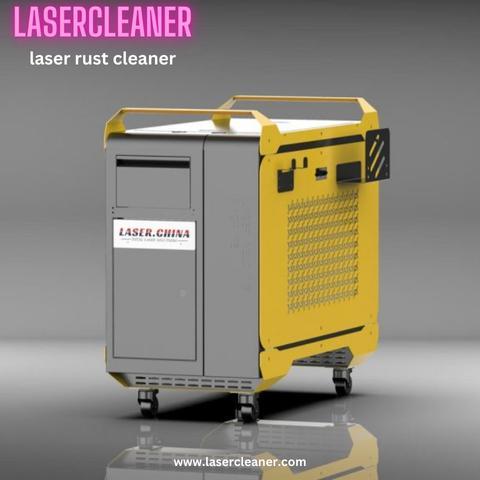Revolutionize Rust Removal: The Ultimate Laser Rust Cleaner Guide

Rust is a persistent problem for metal surfaces, causing structural weakness and aesthetic damage. Traditional methods like sandblasting, chemical treatments, and manual scrubbing are time-consuming, messy, and often harmful to the environment. Enter laser rust cleaner—a cutting-edge, eco-friendly solution that removes rust with precision and efficiency.
This guide explores how laser rust cleaners work, their benefits, applications, and key considerations before purchasing.
How Does a Laser Rust Cleaner Work?
A laser rust cleaner uses high-intensity laser beams to vaporize rust, paint, and other contaminants without damaging the underlying metal. Here’s the science behind it:
-
Laser Ablation: The laser emits focused light energy that breaks the bonds between rust particles and the metal surface.
-
Selective Absorption: Rust absorbs the laser wavelength more efficiently than clean metal, ensuring only the corroded layer is removed.
-
Instant Vaporization: The rust turns into gas or fine dust, leaving a clean, smooth surface.
Key Components of a Laser Rust Cleaner
-
Fiber Laser Source (Common wavelengths: 1064nm, 532nm)
-
Cooling System (Prevents overheating)
-
Control Panel (Adjusts power, speed, and focus)
-
Protective Housing (Ensures safety during operation)
Benefits of Laser Rust Cleaning
| Feature | Traditional Methods | Laser Rust Cleaner |
|---|---|---|
| Precision | Risk of damaging metal | Only removes rust |
| Eco-Friendly | Chemicals & waste | No harmful byproducts |
| Speed | Slow (hours/days) | Fast (minutes) |
| Cost Efficiency | High (consumables, labor) | Low (minimal upkeep) |
| Safety | Hazardous (chemicals, dust) | Non-toxic, minimal debris |
Why Choose Laser Over Traditional Methods?
✔ No Media Waste – Unlike sandblasting, no abrasive materials are needed.
✔ Non-Destructive – Preserves the integrity of the base metal.
✔ Reduced Labor Costs – Automated operation requires minimal manual effort.
✔ Versatile – Works on various metals (steel, iron, aluminum, etc.).
Applications of Laser Rust Cleaners
Laser rust cleaners are used across multiple industries:
1. Automotive & Aerospace
-
Restores vintage car parts.
-
Cleans aircraft components without weakening structural integrity.
2. Manufacturing & Metalworking
-
Prepares surfaces for welding or coating.
-
Removes oxidation from machinery.
3. Marine Industry
-
Cleans ship hulls, propellers, and offshore structures.
4. Historical Restoration
-
Safely removes rust from artifacts without damage.
FAQs About Laser Rust Cleaners
Q: Is laser rust cleaning safe?
A: Yes! Laser cleaning is non-toxic and produces minimal waste. Operators must wear protective goggles to shield against laser reflections.
Q: Can laser cleaners remove paint?
A: Absolutely. Lasers can strip paint, oil, and other coatings without chemicals.
Q: What metals can be cleaned with a laser?
A: Most metals, including:
-
Steel
-
Cast iron
-
Aluminum
-
Copper
(Note: Reflective metals may require adjusted settings.)
Q: How much does a laser rust cleaner cost?
A: Prices range from $10,000 to $100,000+, depending on power and features. Industrial-grade models are more expensive but offer higher efficiency.
Choosing the Right Laser Rust Cleaner
Before investing, consider these factors:
1. Laser Power (Wattage)
-
50W–200W: Ideal for small-scale projects (e.g., jewelry, small parts).
-
500W–1000W+: Best for industrial applications (e.g., large machinery, shipyards).
2. Portability
-
Handheld units offer flexibility.
-
Stationary systems are better for heavy-duty tasks.
3. Safety Features
-
Look for emergency stop buttons, protective enclosures, and fume extractors.
4. Maintenance Requirements
-
Fiber lasers have long lifespans with minimal upkeep.
Laser Rust Cleaning vs. Alternatives
Sandblasting
-
Pros: Effective for thick rust layers.
-
Cons: Creates dust, requires cleanup, damages surfaces over time.
Chemical Strippers
-
Pros: Deep cleaning.
-
Cons: Toxic, hazardous disposal, can weaken metal.
Manual Grinding
-
Pros: Low initial cost.
-
Cons: Labor-intensive, inconsistent results.
Winner? Laser cleaning is the most efficient, precise, and sustainable option.
Future of Laser Rust Cleaning
As technology advances, we can expect:
-
Faster cleaning speeds with higher-powered lasers.
-
AI integration for automated rust detection and removal.
-
More affordable models for small businesses.
laser rust cleaner is transforming industrial maintenance, offering a cleaner, faster, and smarter way to combat corrosion. Whether you're in manufacturing, automotive, or restoration, this innovation delivers unmatched results.
- Information Technology
- Office Equipment and Supplies
- Cars and Trucks
- Persons
- Books and Authors
- Tutorials
- Art
- Causes
- Crafts
- Dance
- Drinks
- Film
- Fitness
- Food
- Oyunlar
- Gardening
- Health
- Home
- Literature
- Music
- Networking
- Other
- Party
- Religion
- Shopping
- Sports
- Theater
- Wellness


